Probabilistic Stability Analysis of Deep Rock Tunnel Excavated by Mechanized Tunneling Considering Anisotropic Initial Stresses
Abstract
:1. Introduction
2. Problem Statement and Chosen Methodologies
2.1. Problem Statement
2.2. Probabilistic Methods
2.2.1. Subset Simulation
2.2.2. Sobol Global Sensitivity Analysis
3. Numerical Results
3.1. Definition of the Reference Case
3.2. Deterministic Analyses
3.3. Probabilistic Analysis of the Reference Case
3.3.1. Estimation
3.3.2. Variation of the Two QoIs
3.3.3. Sensitivity Analysis
3.4. λ Effects with Different Thicknesses of the Liners
4. Conclusions
Author Contributions
Funding
Institutional Review Board Statement
Informed Consent Statement
Data Availability Statement
Conflicts of Interest
List of Notations and Abbreviations
| GM | Shear modulus of Maxwell |
| GK | Shear modulus of Kelvin |
| ηM | Viscosity of Maxwell |
| ηK | Viscosity of Kelvin |
| λ | Anisotropic coefficient |
| P0 | Vertical stress |
| X | Input vector in probabilistic analyses |
| σe (X) | Equivalent stress with a given input vector |
| σe_max | Allowable equivalent stress |
| ϵv (X) | Volumetric strain with a given input vector |
| ϵv_max | Allowable volumetric strain |
| Pf | Failure probability |
| LSF | Limit state surface |
| SS | Subset simulation |
| GSA | Global sensitivity analysis |
| MCS | Monte Carlo Simulation |
| QoI | Quantity of interest |
| RV | Random variable |
| CoV | Coefficient of variation |
References
- Wu, K.; Shao, Z. Study on the Effect of Flexible Layer on Support Structures of Tunnel Excavated in Viscoelastic Rocks. J. Eng. Mech. 2019, 145. [Google Scholar] [CrossRef]
- Lo, K.Y.; Yuen, C.M.K. Design of tunnel lining in rock for long term time effects. Can. Geotech. J. 1981, 18, 24–39. [Google Scholar] [CrossRef]
- Lü, Q.; Low, B.K. Probabilistic analysis of underground rock excavations using response surface method and SORM. Comput. Geotech. 2011, 38, 1008–1021. [Google Scholar] [CrossRef]
- Lü, Q.; Chan, C.L.; Low, B.K. System Reliability Assessment for a Rock Tunnel with Multiple Failure Modes. Rock Mech. Rock Eng. 2012, 46, 821–833. [Google Scholar] [CrossRef]
- Song, F.; Wang, H.; Jiang, M. Analytically-based simplified formulas for circular tunnels with two liners in viscoelastic rock under anisotropic initial stresses. Constr. Build. Mater. 2018, 175, 746–767. [Google Scholar] [CrossRef]
- Wang, H.; Song, F.; Zhao, T.; Jiang, M. Solutions for lined circular tunnels sequentially constructed in rheological rock subjected to non-hydrostatic initial stresses. Eur. J. Environ. Civ. Eng. 2020, 26, 1834–1866. [Google Scholar] [CrossRef]
- Mollon, G.; Dias, D.; Soubra, A.-H. Probabilistic Analysis of Circular Tunnels in Homogeneous Soil Using Response Surface Methodology. J. Geotech. Geoenvironmental Eng. 2009, 135, 1314–1325. [Google Scholar] [CrossRef] [Green Version]
- Li, H.-Z.; Low, B.K. Reliability analysis of circular tunnel under hydrostatic stress field. Comput. Geotech. 2010, 37, 50–58. [Google Scholar] [CrossRef]
- Sulem, J.; Panet, M.; Guenot, A. An analytical solution for time-dependent displacements in a circular tunnel. Int. J. Rock Mech. Min. Sci. Géoméch. Abstr. 1987, 24, 155–164. [Google Scholar] [CrossRef]
- Barla, G.; Debernardi, D.; Sterpi, D. Time-Dependent Modeling of Tunnels in Squeezing Conditions. Int. J. Géoméch. 2012, 12, 697–710. [Google Scholar] [CrossRef]
- Sharifzadeh, M.; Tarifard, A.; Moridi, M.A. Time-dependent behavior of tunnel lining in weak rock mass based on displacement back analysis method. Tunn. Undergr. Space Technol. 2013, 38, 348–356. [Google Scholar] [CrossRef]
- Fahimifar, A.; Tehrani, F.M.; Hedayat, A.; Vakilzadeh, A. Analytical solution for the excavation of circular tunnels in a visco-elastic Burger’s material under hydrostatic stress field. Tunn. Undergr. Space Technol. 2010, 25, 297–304. [Google Scholar] [CrossRef]
- Nomikos, P.; Rahmannejad, R.; Sofianos, A. Supported Axisymmetric Tunnels Within Linear Viscoelastic Burgers Rocks. Rock Mech. Rock Eng. 2011, 44, 553–564. [Google Scholar] [CrossRef]
- Song, F.; Wang, H.; Jiang, M. Analytical solutions for lined circular tunnels in viscoelastic rock considering various interface conditions. Appl. Math. Model. 2018, 55, 109–130. [Google Scholar] [CrossRef]
- Wang, H.N.; Li, Y.; Ni, Q.; Utili, S.; Jiang, M.J.; Liu, F. Analytical Solutions for the Construction of Deeply Buried Circular Tunnels with Two Liners in Rheological Rock. Rock Mech. Rock Eng. 2013, 46, 1481–1498. [Google Scholar] [CrossRef]
- Wang, H.; Utili, S.; Jiang, M. An analytical approach for the sequential excavation of axisymmetric lined tunnels in viscoelastic rock. Int. J. Rock Mech. Min. Sci. 2014, 68, 85–106. [Google Scholar] [CrossRef]
- Do, D.-P.; Tran, N.-T.; Mai, V.-T.; Hoxha, D.; Vu, M.-N. Time-Dependent Reliability Analysis of Deep Tunnel in the Viscoelastic Burger Rock with Sequential Installation of Liners. Rock Mech. Rock Eng. 2019, 53, 1259–1285. [Google Scholar] [CrossRef]
- Kargar, A.R.; Haghgouei, H. An analytical solution for time-dependent stress field of lined circular tunnels using complex potential functions in a stepwise procedure. Appl. Math. Model. 2019, 77, 1625–1642. [Google Scholar] [CrossRef]
- Mogilevskaya, S.G.; Lecampion, B. A lined hole in a viscoelastic rock under biaxial far-field stress. Int. J. Rock Mech. Min. Sci. 2018, 106, 350–363. [Google Scholar] [CrossRef]
- Au, S.-K.; Beck, J.L. Estimation of small failure probabilities in high dimensions by subset simulation. Probabilistic Eng. Mech. 2001, 16, 263–277. [Google Scholar] [CrossRef] [Green Version]
- Li, H.-S.; Cao, Z.-J. Matlab codes of Subset Simulation for reliability analysis and structural optimization. Struct. Multidiscip. Optim. 2016, 54, 391–410. [Google Scholar] [CrossRef]
- Papaioannou, I.; Betz, W.; Zwirglmaier, K.; Straub, D. MCMC algorithms for Subset Simulation. Probabilistic Eng. Mech. 2015, 41, 89–103. [Google Scholar] [CrossRef]
- Zuev, K.M.; Beck, J.L.; Au, S.-K.; Katafygiotis, L.S. Bayesian post-processor and other enhancements of Subset Simulation for estimating failure probabilities in high dimensions. Comput. Struct. 2012, 92–93, 283–296. [Google Scholar] [CrossRef] [Green Version]
- Guo, X.; Dias, D.; Carvajal, C.; Peyras, L.; Breul, P. A comparative study of different reliability methods for high dimensional stochastic problems related to earth dam stability analyses. Eng. Struct. 2019, 188, 591–602. [Google Scholar] [CrossRef]
- Jiang, S.-H.; Huang, J.; Zhou, C.-B. Efficient system reliability analysis of rock slopes based on Subset simulation. Comput. Geotech. 2016, 82, 31–42. [Google Scholar] [CrossRef]
- Zhang, T.; Guo, X.; Dias, D.; Sun, Z. Dynamic probabilistic analysis of non-homogeneous slopes based on a simplified deterministic model. Soil Dyn. Earthq. Eng. 2021, 142, 106563. [Google Scholar] [CrossRef]
- Sudret, B. Global sensitivity analysis using polynomial chaos expansions. Reliab. Eng. Syst. Saf. 2008, 93, 964–979. [Google Scholar] [CrossRef]
- Saltelli, A.; Annoni, P.; Azzini, I.; Campolongo, F.; Ratto, M.; Tarantola, S. Variance based sensitivity analysis of model output. Design and estimator for the total sensitivity index. Comput. Phys. Commun. 2010, 181, 259–270. [Google Scholar] [CrossRef]
- Iooss, B.; Lemaître, P. A review on global sensitivity analysis methods. In Uncertainty Management in Simulation-Optimization of Complex Systems: Algorithms and Applications; Meloni, C., Dellino, G., Eds.; Springer: Berlin/Heidelberg, Germany, 2015. [Google Scholar] [CrossRef] [Green Version]
- Guo, X.; Dias, D.; Carvajal, C.; Peyras, L.; Breul, P. Three-dimensional probabilistic stability analysis of an earth dam using an active learning metamodeling approach. Bull. Eng. Geol. Environ. 2021, 81, 40. [Google Scholar] [CrossRef]
- Lo, M.K.; Leung, Y.F. Reliability Assessment of Slopes Considering Sampling Influence and Spatial Variability by Sobol’ Sensitivity Index. J. Geotech. Geoenvironmental Eng. 2018, 144. [Google Scholar] [CrossRef]
- Zhou, S.; Guo, X.; Zhang, Q.; Dias, D.; Pan, Q. Influence of a weak layer on the tunnel face stability—Reliability and sensitivity analysis. Comput. Geotech. 2020, 122, 103507. [Google Scholar] [CrossRef]
- Armand, G.; Noiret, A.; Zghondi, J.; Seyedi, D. Short- and long-term behaviors of drifts in the Callovo-Oxfordian claystone at the Meuse/Haute-Marne Underground Research Laboratory. J. Rock Mech. Geotech. Eng. 2013, 5, 221–230. [Google Scholar] [CrossRef] [Green Version]
- Guo, X.; Pham, T.A.; Dias, D. Probabilistic analysis of geosynthetic-reinforced and pile-supported embankments. Comput. Geotech. 2021, 142, 104595. [Google Scholar] [CrossRef]
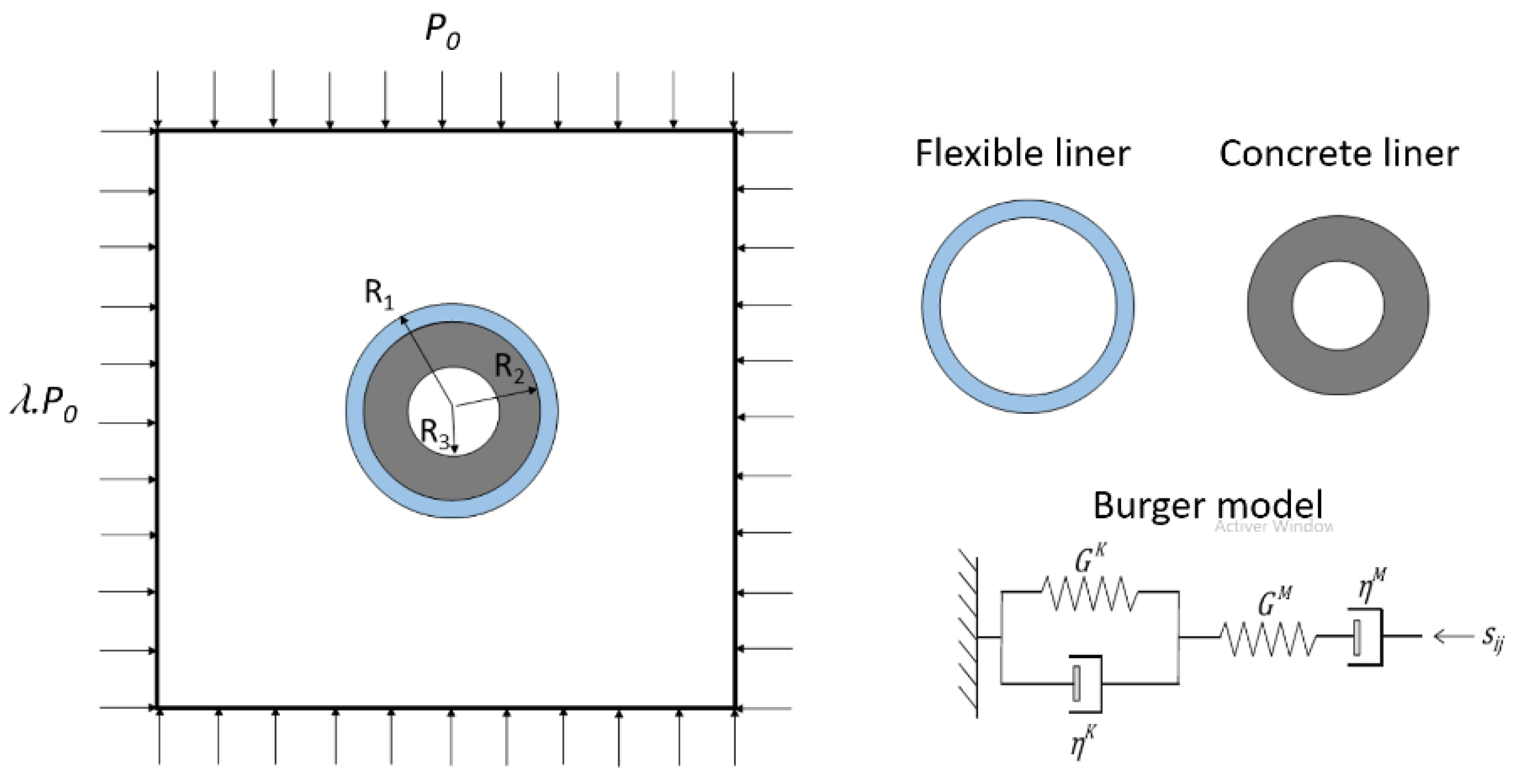
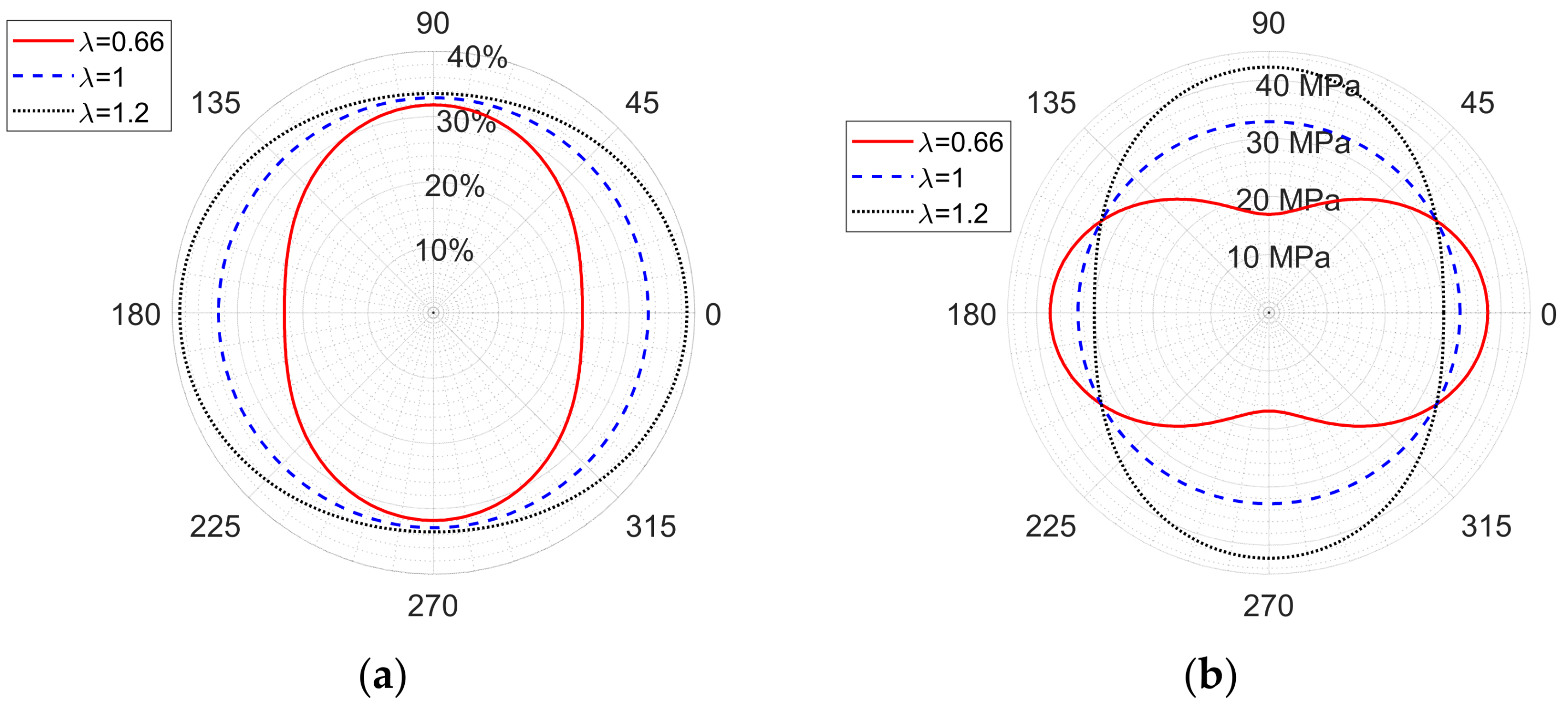
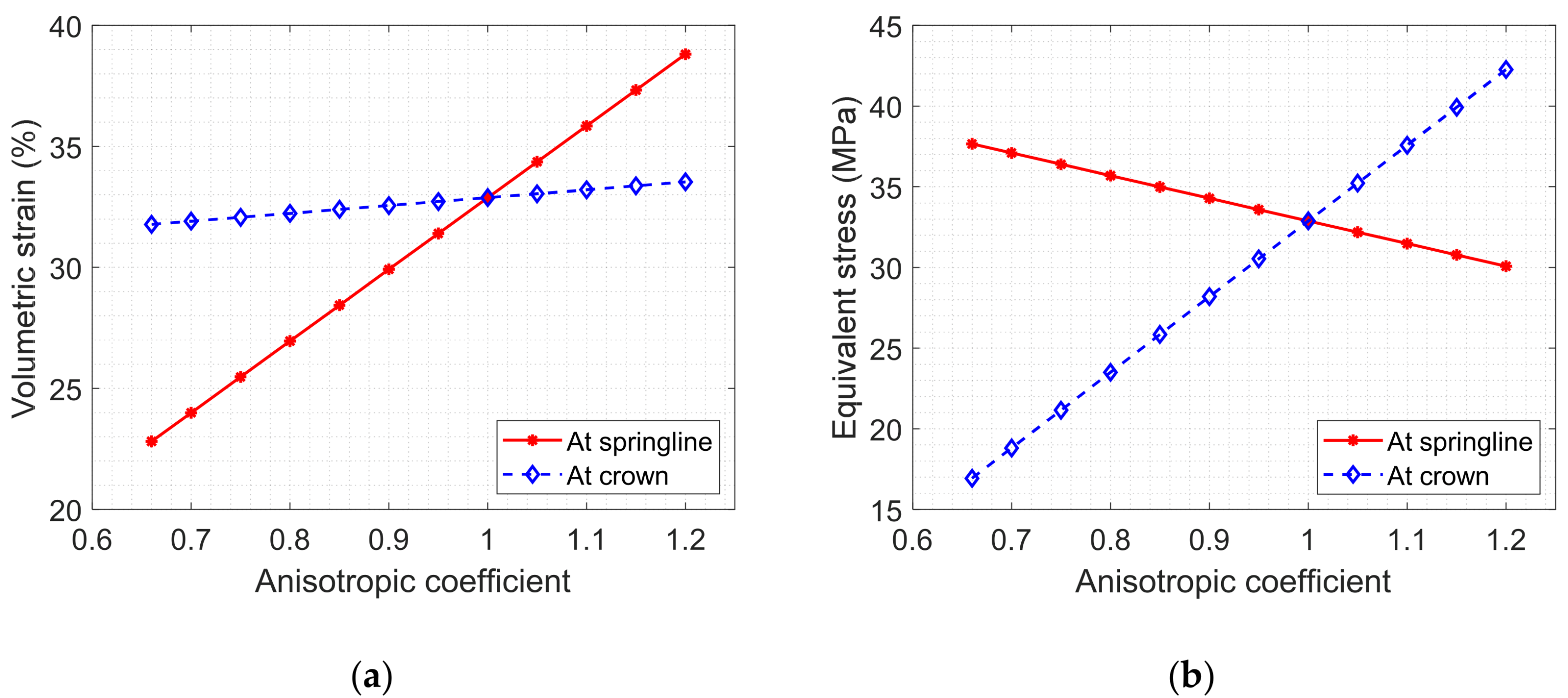
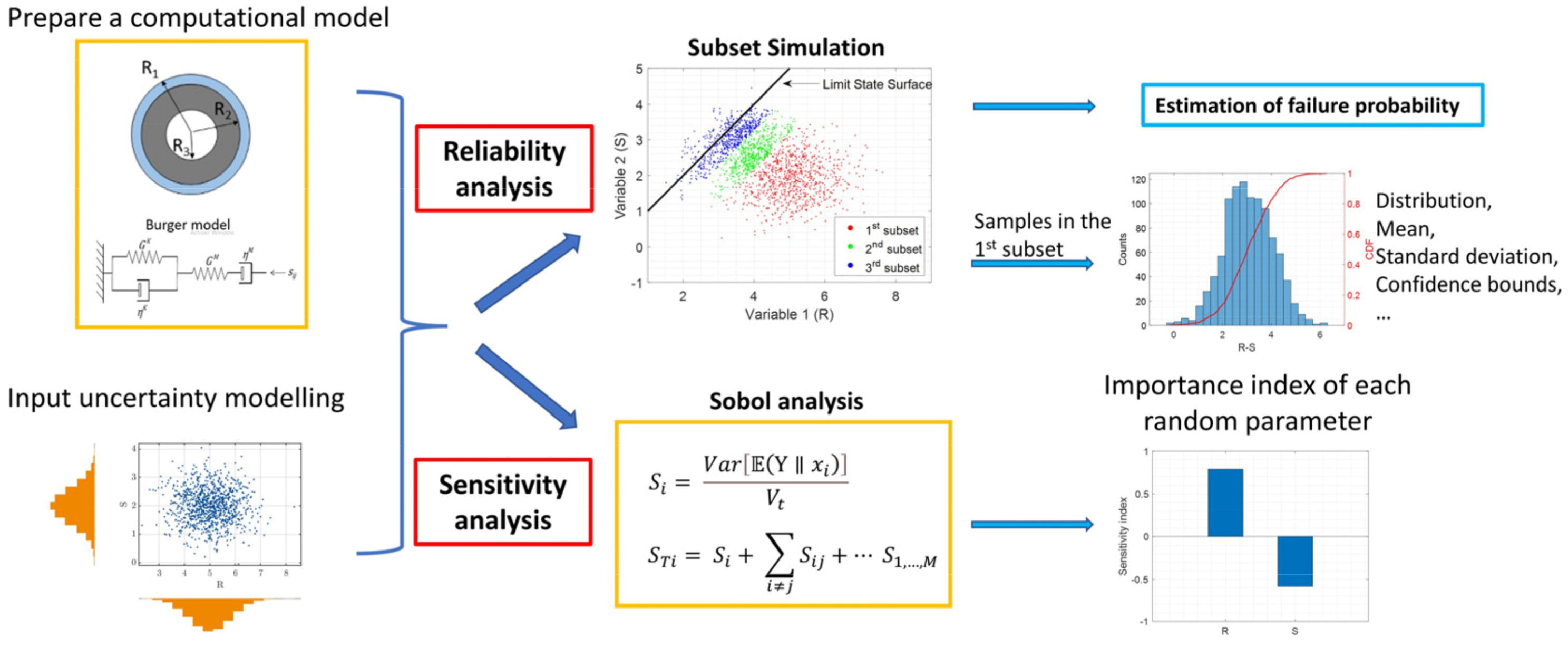
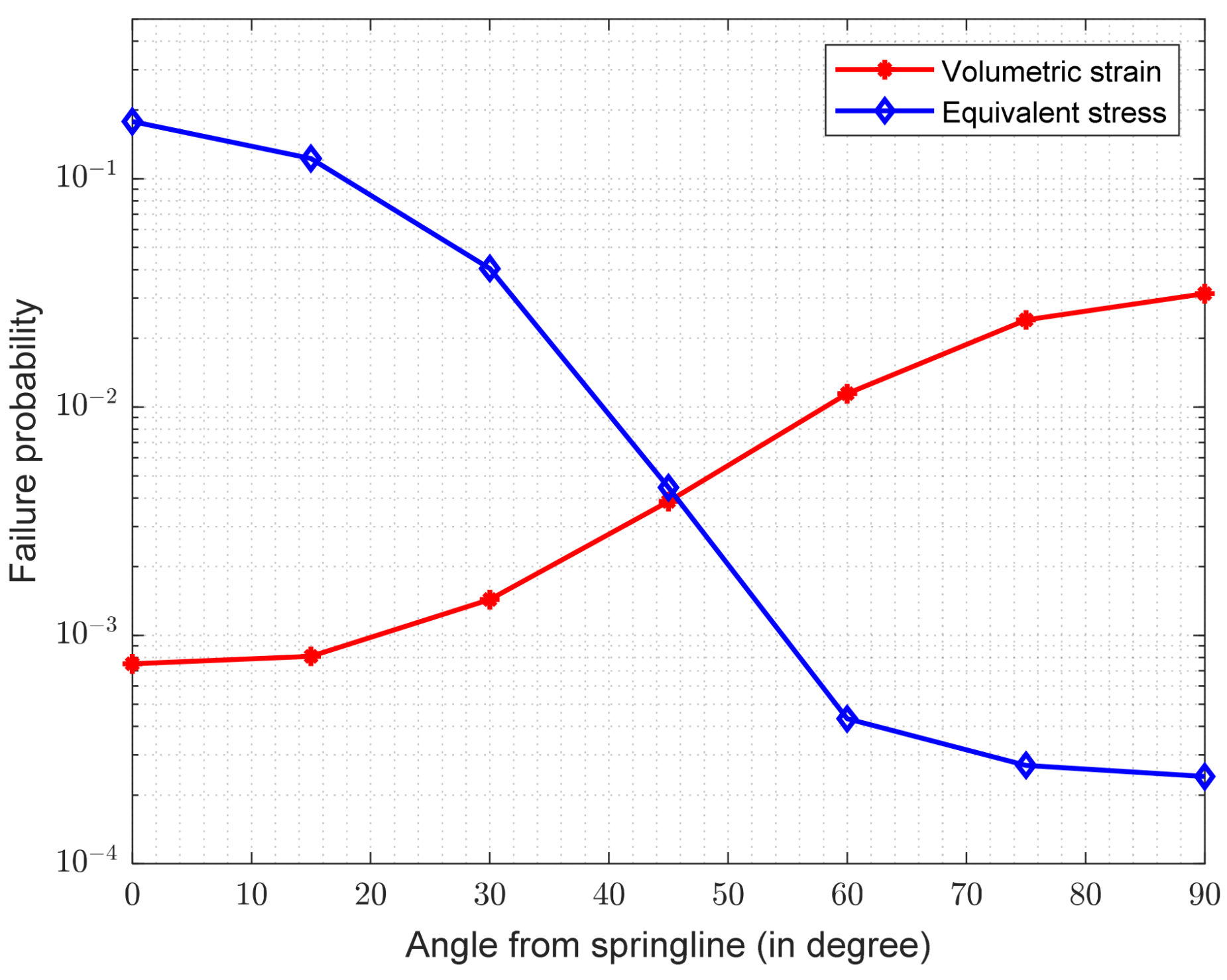
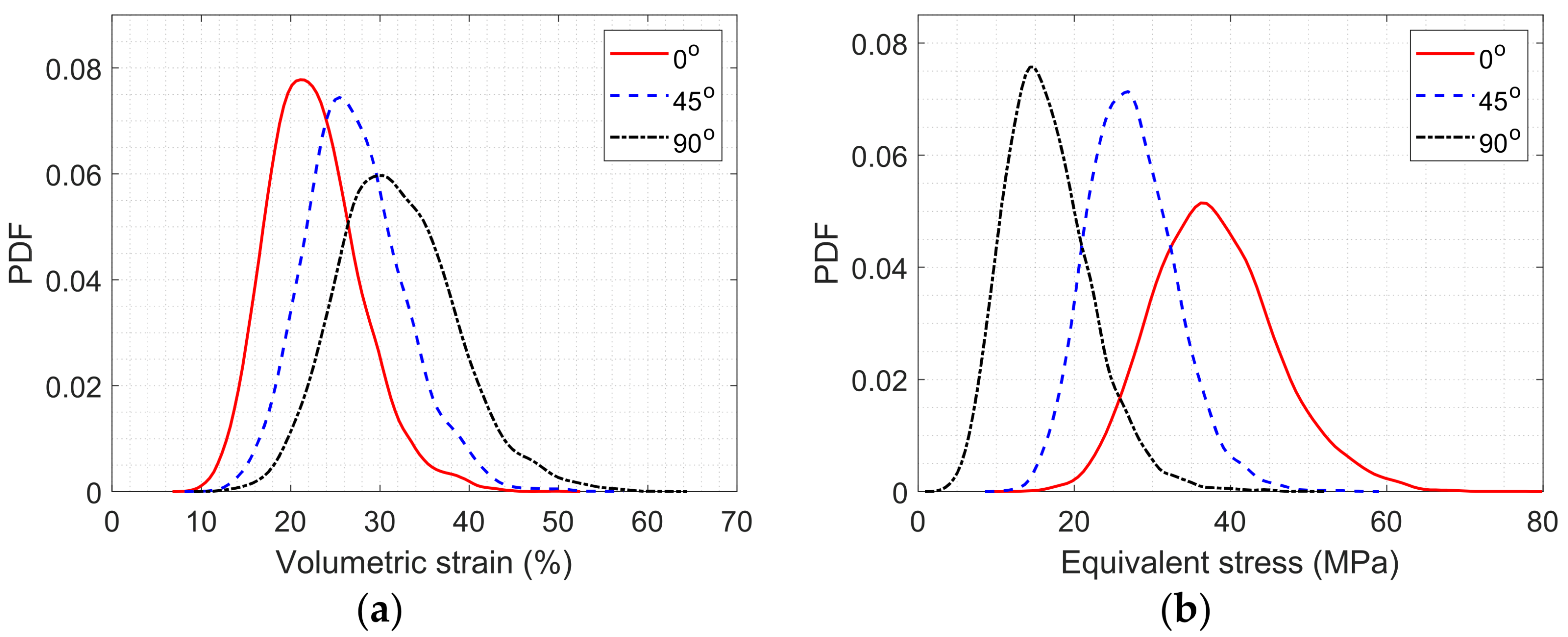
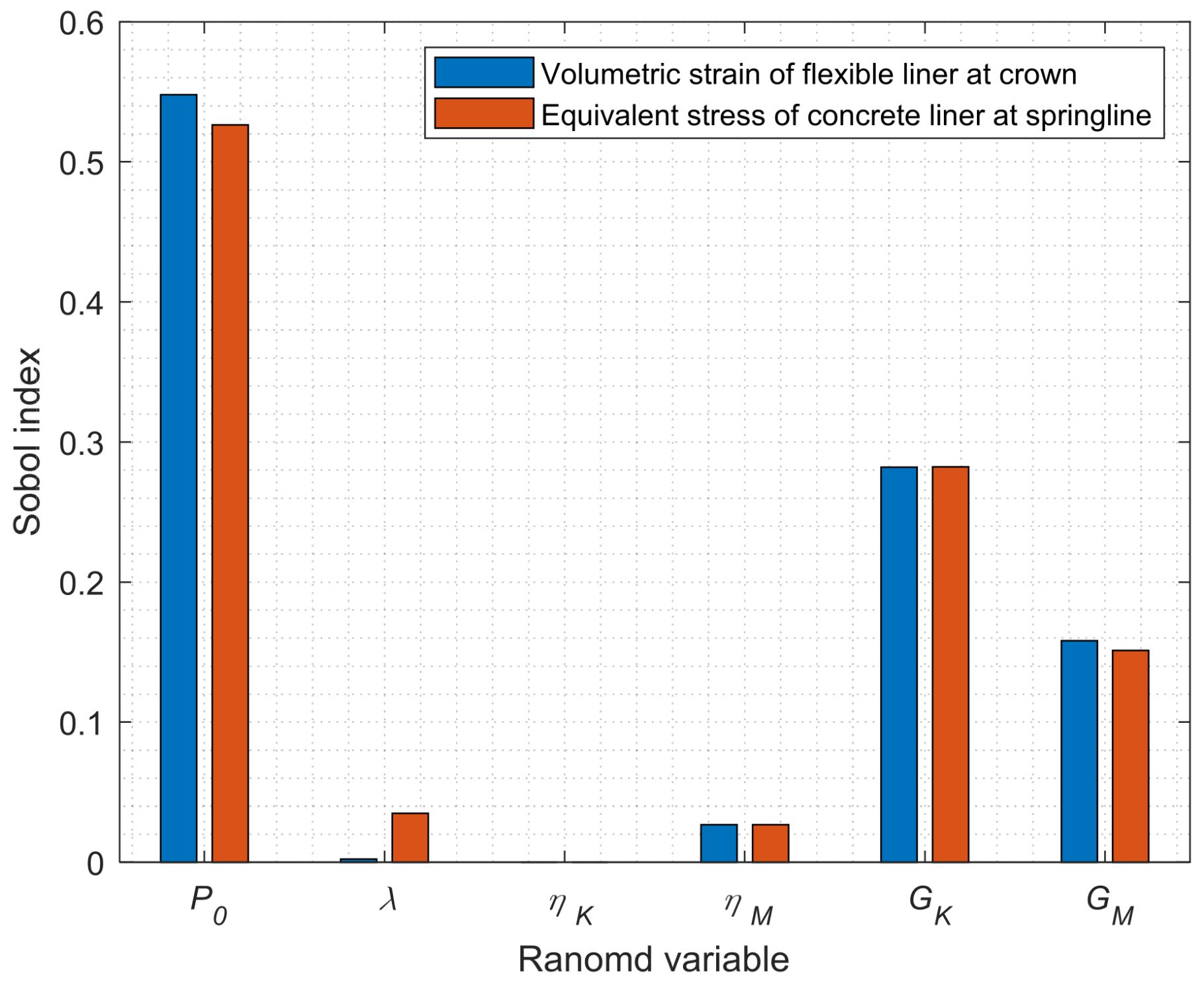
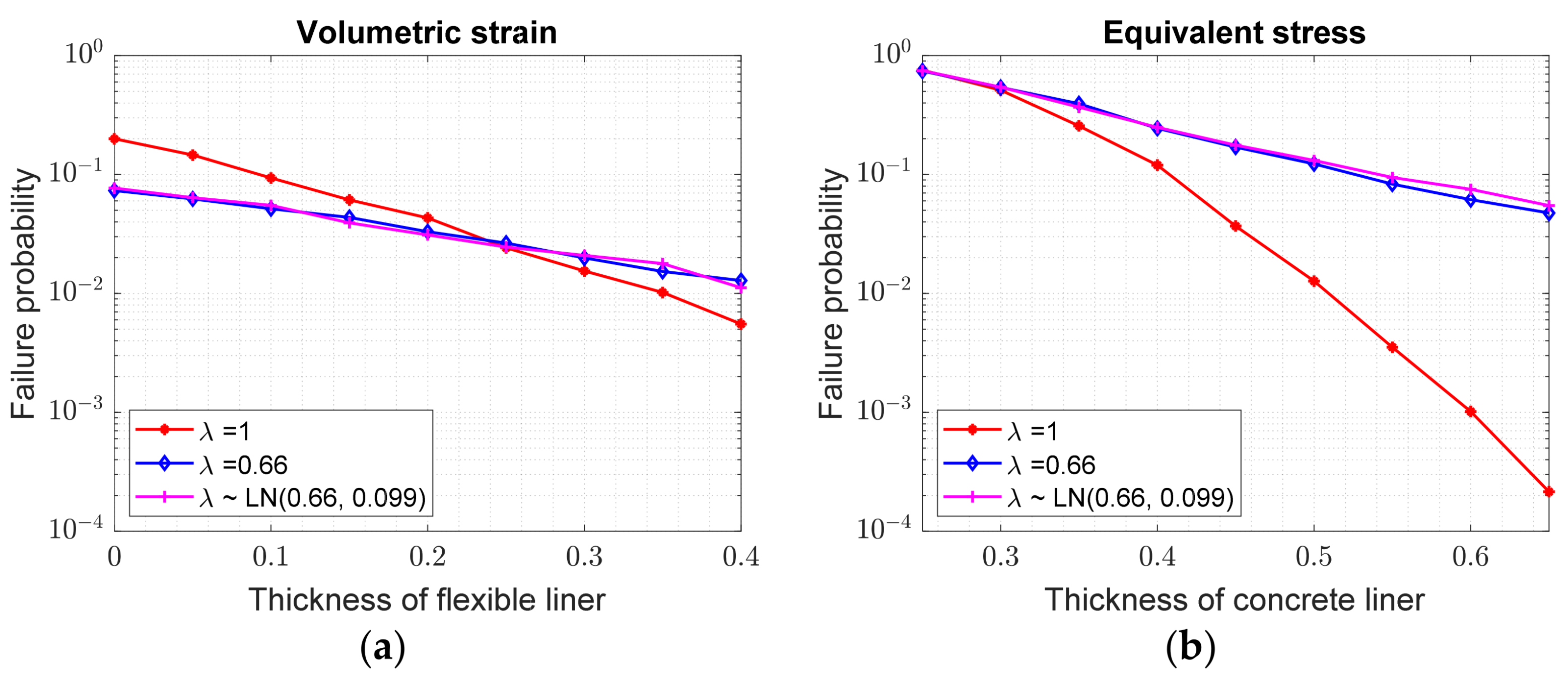

| Parameter | Symbol | Value | |
|---|---|---|---|
| Initial stress | Vertical stress | 6.8 MPa | |
| Anisotropic coefficient | 0.66 | ||
| Burger model | Viscosity of Kelvin | 2. 07 × 107 GPa.s | |
| Viscosity of Maxwell | 4. 14 × 109 GPa.s | ||
| Shear modulus of Kelvin | 0.34 GPa | ||
| Shear modulus of Maxwell | 3.45 GPa | ||
| Geometry | Tunnel radius | 4.5 | |
| Thickness of 1st liner | 0.2 | ||
| Thickness of 2nd liner | 0.45 | ||
| Two liners | Elastic modulus of 1st liner | 0.1 GPa | |
| Elastic modulus of 2nd liner | 30 GPa | ||
| Poisson coefficient of 1st liner | 0.001 | ||
| Poisson coefficient of 2nd liner | 0.2 | ||
| Others | Installation time of the two liners | 0.001 day | |
| Excavation rate | 0.75 m/day | ||
| 1st parameter of deconfinement rate function | 0.7 | ||
| 2nd parameter of deconfinement rate function | 1 |
| Parameter | Symbol | Unit | Distribution | Mean | CoV |
|---|---|---|---|---|---|
| Vertical stress | MPa | Lognormal | 6.8 | 15% | |
| Anisotropic coefficient | / | Lognormal | 0.66 | 15% | |
| Viscosity of Kelvin | GPa.s | Lognormal | 2.07 × 107 | 15% | |
| Viscosity of Maxwell | GPa.s | Lognormal | 4.14 × 109 | 15% | |
| Shear modulus of Kelvin | GPa | Lognormal | 0.35 | 15% | |
| Shear modulus of Maxwell | GPa | Lognormal | 3.45 | 15% |
| Angle | Volumetric Strain (%) | Equivalent Stress (MPa) | ||||||
|---|---|---|---|---|---|---|---|---|
| Mean | Std (1) | Low (2) | Up (3) | Mean | Std | Low | Up | |
| 0 | 22.69 | 5.19 | 14.00 | 34.31 | 37.96 | 7.89 | 24.14 | 55.22 |
| 45 | 27.19 | 5.57 | 17.23 | 39.28 | 27.39 | 5.61 | 17.71 | 39.61 |
| 90 | 31.88 | 6.58 | 20.35 | 46.50 | 16.70 | 5.62 | 7.71 | 29.47 |
Publisher’s Note: MDPI stays neutral with regard to jurisdictional claims in published maps and institutional affiliations. |
© 2022 by the authors. Licensee MDPI, Basel, Switzerland. This article is an open access article distributed under the terms and conditions of the Creative Commons Attribution (CC BY) license (https://creativecommons.org/licenses/by/4.0/).
Share and Cite
Do, D.P.; Guo, X.; Dias, D. Probabilistic Stability Analysis of Deep Rock Tunnel Excavated by Mechanized Tunneling Considering Anisotropic Initial Stresses. Appl. Sci. 2022, 12, 7479. https://doi.org/10.3390/app12157479
Do DP, Guo X, Dias D. Probabilistic Stability Analysis of Deep Rock Tunnel Excavated by Mechanized Tunneling Considering Anisotropic Initial Stresses. Applied Sciences. 2022; 12(15):7479. https://doi.org/10.3390/app12157479
Chicago/Turabian StyleDo, Duc Phi, Xiangfeng Guo, and Daniel Dias. 2022. "Probabilistic Stability Analysis of Deep Rock Tunnel Excavated by Mechanized Tunneling Considering Anisotropic Initial Stresses" Applied Sciences 12, no. 15: 7479. https://doi.org/10.3390/app12157479
APA StyleDo, D. P., Guo, X., & Dias, D. (2022). Probabilistic Stability Analysis of Deep Rock Tunnel Excavated by Mechanized Tunneling Considering Anisotropic Initial Stresses. Applied Sciences, 12(15), 7479. https://doi.org/10.3390/app12157479








